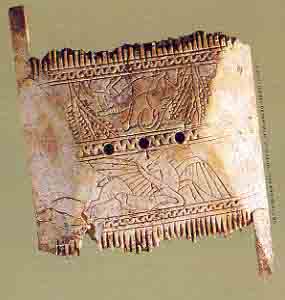Image Details

T. Sagiv, Israel Department of Antiquities and Museums
“Hold still!” a mother in ancient times might have said to a squirming child as she raked through tangled hair with a fine-tooth comb similar to this one. Telltale louse eggs found between the teeth of ancient combs show that when it comes to Pediculus capitis and Pediculus humanus—the common human head and body louse—the practice of delousing has barely changed over 3,000 years!
This comb, carved from ivory in the Phoenician style, dates to about the 13th–12th centuries B.C. and comes from Megiddo. Two panels decorate the comb. The upper panel (seen upside down in this view) shows an ibex, a wild goat with prominent curved horns, kneeling between two trees, while the lower panel depicts a mythological winged creature resting on one knee.
